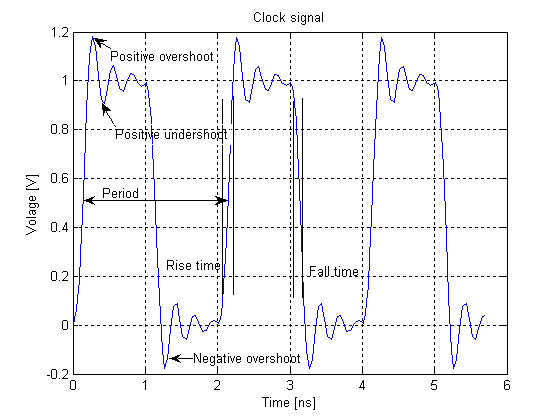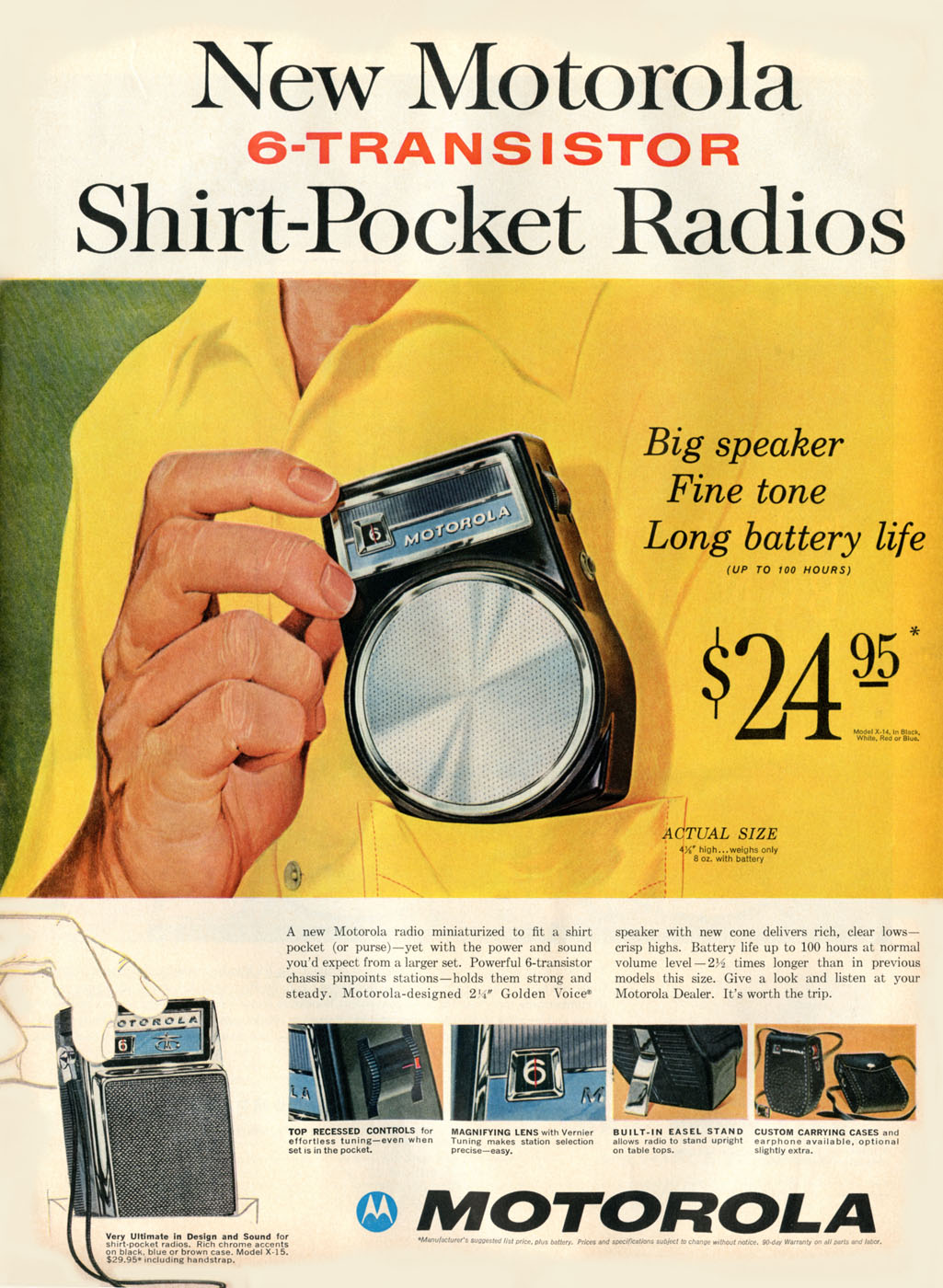|
Clock Signal
In electronics and especially synchronous digital circuits, a clock signal (historically also known as ''logic beat'') is an electronic logic signal (voltage or current) which oscillates between a high and a low state at a constant frequency and is used like a metronome to synchronize actions of digital circuits. In a synchronous logic circuit, the most common type of digital circuit, the clock signal is applied to all storage devices, flip-flops and latches, and causes them all to change state simultaneously, preventing race conditions. A clock signal is produced by an electronic oscillator called a clock generator. The most common clock signal is in the form of a square wave with a 50% duty cycle. Circuits using the clock signal for synchronization may become active at either the rising edge, falling edge, or, in the case of double data rate, both in the rising and in the falling edges of the clock cycle. Digital circuits Most integrated circuits (ICs) of suffi ... [...More Info...] [...Related Items...] OR: [Wikipedia] [Google] [Baidu] |
Double Data Rate
In computing, double data rate (DDR) describes a computer bus that transfers data on both the rising and falling edges of the clock signal and hence doubles the memory bandwidth by transferring data twice per clock cycle. This is also known as double pumped, dual-pumped, and double transition. The term toggle mode is used in the context of NAND flash memory. Overview The simplest way to design a clocked electronic circuit is to make it perform one transfer per full cycle (rise and fall) of a clock signal. This, however, requires that the clock signal changes twice per transfer, while the data lines change at most once per transfer. When operating at a high bandwidth, signal integrity limitations constrain the clock frequency. By using both edges of the clock, the data signals operate with the same limiting frequency, thereby doubling the data transmission rate. This technique has been used for microprocessor front-side busses, Ultra-3 SCSI, expansion buses ( AGP, PCI ... [...More Info...] [...Related Items...] OR: [Wikipedia] [Google] [Baidu] |
Intel 8080
The Intel 8080 is Intel's second 8-bit computing, 8-bit microprocessor. Introduced in April 1974, the 8080 was an enhanced successor to the earlier Intel 8008 microprocessor, although without binary compatibility.'' Electronic News'' was a weekly trade newspaper. The same advertisement appeared in the :File:Intel 8080 Advertisement May 1974.jpg, May 2, 1974, issue of ''Electronics'' magazine. Originally intended for use in Embedded system, embedded systems such as calculators, cash registers, computer terminals, and industrial robots, its robust performance soon led to adoption in a broader range of systems, ultimately helping to launch the microcomputer industry. Several key design choices contributed to the 8080’s success. Its 40‑pin package simplified interfacing compared to the 8008’s 18‑pin design, enabling a more efficient data bus. The transition to NMOS logic, NMOS technology provided faster transistor speeds than the 8008's PMOS logic, PMOS while also simplifyin ... [...More Info...] [...Related Items...] OR: [Wikipedia] [Google] [Baidu] |
Motorola 6800
The 6800 ("''sixty-eight hundred''") is an 8-bit microprocessor designed and first manufactured by Motorola in 1974. The MC6800 microprocessor was part of the M6800 Microcomputer System (later dubbed ''68xx'') that also included serial and parallel interface ICs, RAM, ROM and other support chips. A significant design feature was that the M6800 family of ICs required only a single five-volt power supply at a time when most other microprocessors required three voltages. The M6800 Microcomputer System was announced in March 1974 and was in full production by the end of that year. "Motorola's M6800 microcomputer system, which can operate from a single 5-volt supply, is moving out of the sampling stage and into full production." The small-quantity price of the MC6800 is . The MC6820 PIA cost . American Microsystems was licensed as the second source. The 6800 has a 16-bit address bus that can directly access of memory and an 8-bit bi-directional data bus. It has 72 instructions with ... [...More Info...] [...Related Items...] OR: [Wikipedia] [Google] [Baidu] |
Metal Oxide Semiconductor
upright=1.3, Two power MOSFETs in amperes">A in the ''on'' state, dissipating up to about 100 watt">W and controlling a load of over 2000 W. A matchstick is pictured for scale. In electronics, the metal–oxide–semiconductor field-effect transistor (MOSFET, MOS-FET, MOS FET, or MOS transistor) is a type of field-effect transistor (FET), most commonly fabricated by the controlled oxidation of silicon. It has an insulated gate, the voltage of which determines the conductivity of the device. This ability to change conductivity with the amount of applied voltage can be used for amplifying or switching electronic signals. The term ''metal–insulator–semiconductor field-effect transistor'' (''MISFET'') is almost synonymous with ''MOSFET''. Another near-synonym is ''insulated-gate field-effect transistor'' (''IGFET''). The main advantage of a MOSFET is that it requires almost no input current to control the load current under steady-state or low-frequency conditions, e ... [...More Info...] [...Related Items...] OR: [Wikipedia] [Google] [Baidu] |
State (computer Science)
In information technology and computer science, a system is described as stateful if it is designed to remember preceding events or user interactions; the remembered information is called the state of the system. The set of states a system can occupy is known as its state space. In a discrete system, the state space is countable and often finite. The system's internal behaviour or interaction with its environment consists of separately occurring individual actions or events, such as accepting input or producing output, that may or may not cause the system to change its state. Examples of such systems are digital logic circuits and components, automata and formal language, computer programs, and computers. The output of a digital circuit or deterministic computer program at any time is completely determined by its current inputs and its state. Digital logic circuit state Digital logic circuits can be divided into two types: combinational logic, whose output signals a ... [...More Info...] [...Related Items...] OR: [Wikipedia] [Google] [Baidu] |
Edge-triggered Flip-flop
In electronics, flip-flops and latches are circuits that have two stable states that can store state information – a bistable multivibrator. The circuit can be made to change state by signals applied to one or more control inputs and will output its state (often along with its logical complement too). It is the basic storage element in sequential logic. Flip-flops and latches are fundamental building blocks of digital electronics systems used in computers, communications, and many other types of systems. Flip-flops and latches are used as data storage elements to store a single ''bit'' (binary digit) of data; one of its two states represents a "one" and the other represents a "zero". Such data storage can be used for storage of ''state'', and such a circuit is described as sequential logic in electronics. When used in a finite-state machine, the output and next state depend not only on its current input, but also on its current state (and hence, previous inputs). It can also ... [...More Info...] [...Related Items...] OR: [Wikipedia] [Google] [Baidu] |
Synchronous Circuit
In digital electronics, a synchronous circuit is a digital circuit in which the changes in the state (computer science), state of memory elements are synchronized by a clock signal. In a sequential logic, sequential digital logic circuit, data is stored in memory devices called flip-flop (electronics), flip-flops or latches. The output of a flip-flop is constant until a pulse is applied to its "clock" input, upon which the input of the flip-flop is latched into its output. In a synchronous logic circuit, an electronic oscillator called the ''clock (computing), clock'' generates a string (sequence) of pulses, the "clock signal". This clock signal is applied to every storage element, so in an ideal synchronous circuit, every change in the logic level, logical levels of its storage components is simultaneous. Ideally, the input to each storage element has reached its final value before the next clock occurs, so the behaviour of the whole circuit can be predicted exactly. Pract ... [...More Info...] [...Related Items...] OR: [Wikipedia] [Google] [Baidu] |
Asynchronous Processor
Asynchronous circuit (clockless or self-timed circuit) is a sequential digital logic circuit that does not use a global clock circuit or signal generator to synchronize its components. Instead, the components are driven by a handshaking circuit which indicates a completion of a set of instructions. Handshaking works by simple data transfer protocols. Many synchronous circuits were developed in early 1950s as part of bigger asynchronous systems (e.g. ORDVAC). Asynchronous circuits and theory surrounding is a part of several steps in integrated circuit design, a field of digital electronics engineering. Asynchronous circuits are contrasted with synchronous circuits, in which changes to the signal values in the circuit are triggered by repetitive pulses called a clock signal. Most digital devices today use synchronous circuits. However asynchronous circuits have a potential to be much faster, have a lower level of power consumption, electromagnetic interference, and better modu ... [...More Info...] [...Related Items...] OR: [Wikipedia] [Google] [Baidu] |
Asynchronous Circuit
Asynchronous circuit (clockless or self-timed circuit) is a sequential logic, sequential digital logic electrical network, circuit that does not use a global clock circuit or clock signal, signal generator to synchronize its components. Instead, the components are driven by a handshaking circuit which indicates a completion of a set of instructions. Handshaking works by simple data transfer Communications protocol, protocols. Many synchronous circuits were developed in early 1950s as part of bigger asynchronous systems (e.g. ORDVAC). Asynchronous circuits and theory surrounding is a part of several steps in integrated circuit design, a field of digital electronics engineering. Asynchronous circuits are contrasted with synchronous circuits, in which changes to the signal values in the circuit are triggered by repetitive pulses called a clock signal. Most digital devices today use synchronous circuits. However asynchronous circuits have a potential to be much faster, have a lower ... [...More Info...] [...Related Items...] OR: [Wikipedia] [Google] [Baidu] |
Crystal Oscillator
A crystal oscillator is an electronic oscillator Electrical circuit, circuit that uses a piezoelectricity, piezoelectric crystal as a frequency selective surface, frequency-selective element. The oscillator frequency is often used to keep track of time, as in quartz clock, quartz wristwatches, to provide a stable clock signal for digital data, digital integrated circuits, and to stabilize frequencies for radio transmitters and radio receiver, receivers. The most common type of piezoelectric resonator used is a quartz crystal, so oscillator circuits incorporating them became known as crystal oscillators. However, other piezoelectric materials including polycrystalline ceramics are used in similar circuits. A crystal oscillator relies on the slight change in shape of a quartz crystal under an electric field, a property known as inverse piezoelectricity. A voltage applied to the electrodes on the crystal causes it to change shape; when the voltage is removed, the crystal generates ... [...More Info...] [...Related Items...] OR: [Wikipedia] [Google] [Baidu] |


